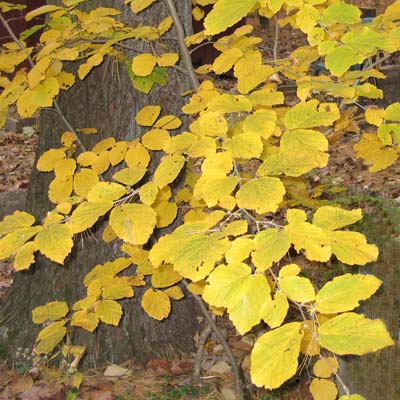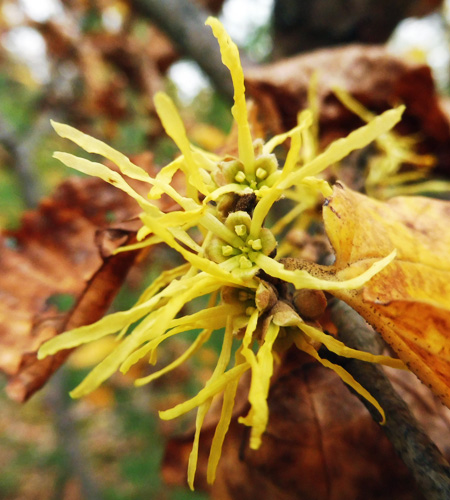Home Resources Gardener News reprints: Mystery Native Plant
This article by Hubert Ling (NPSNJ horticulture) was published in Gardener's News without the photos. He is a regular contributing writer to Gardener's News. Photos by H & M Ling.
Mystery Native Plant

What common but greatly underutilized hardy garden shrub has yellow, orange, or red leaves in fall? Then it produces fragrant, orange, pink, or yellow flowers. This plant is just about the only shrub to bloom in late fall and late winter. It is the only plant in North America which has flowers, ripe fruit, and next year’s buds all together at the same time.
Have you guessed it? It’s witch hazel! The Ozark witch hazel blooms in February, while our native NJ witch hazel, Hamamelis virginiana, blooms in October and November for 4 to 6 weeks. Thus you can extend your native garden blooming season from February to November. The distinctive witch hazel flower clusters are formed from twisted thin yellow ribbon-like petals projecting out in all directions to create delicate pom-poms which look like miniature party decorations. Asian species of witch hazel are also becoming popular but they lack the delightful spicy fragrance of our native species.

The yellow petals and nectar placed near the pollen bearing stamens indicated that these plants were insect pollenated but careful observations never found any consistent pollinator. This genuine mystery lasted for many years until the persistent naturalist, Bernd Heinrich, reported in 1987 that winter flying owlet moths (family Noctuidae, genus Eupsilia) pollinate the Ozark and our NJ witch hazel during the night. These remarkable moths can raise their internal body temperature 63°F or more and fly any winter night which is above freezing. Owlet moths raise their body temperature the same way we do by shivering and thus are affectionately named shivering moths!
Our native NJ witch hazel is widespread throughout Eastern North America. It is a large bush or small tree generally maturing at 12-20’ feet high. Witch hazels are commonly found growing in moist, slightly acidic soil along shady stream banks but the plant is tolerant of full sun and a range of soil types. Give it a non-compacting mulch since the plant can be stressed by drought. This plant is generally disease free but may receive minor damage from Japanese beetles and occasionally a few leaves will show galls from a small wasp.
The fragrant wispy yellow flowers are followed by woody, inedible, nut like fruits which mature in a year and contain one or 2 shiny black seeds. These are tossed up to 30’ when the ripening fruits explosively open. Propagation is done by using stratified seeds which generally take 1-2 years to germinate and the plants take 6 years to bloom. You may want to seriously consider buying 3 to 6 year old plants.
Native Americans had a wide variety of medicinal uses for witch hazel. A leaf tea was used for colds and sore throats. In addition, tea made from twigs was rubbed on legs to relieve lameness, drunk for asthma, bloody dysentery, and cough. Also a bark tea was drunk for lung ailments, and used externally for aching muscles and eye infections.
Various astringent tannins in the leaves and bark are believed to be the active ingredients. Astringents act to contract skin and intestinal tissue and thus act to prevent bleeding. Tannins also show considerable antibacterial and antifungal activity which is probably why these compounds are present in the leaves and bark of numerous plants.
Witch hazel is one of the few medicinal preparations still used today for the same ailments that the native Americans used them for thousands of years ago. The USDA classifies witch hazel as a Class #1 drug which means it has clinically proven beneficial effects. Many commercial extracts contain isopropyl alcohol and are used externally only. Depending on the preparation, read instructions carefully, witch hazel is used for insect bites, sunburn, menstrual flow, eye washes, as a deodorant, to clear spotty skin, to remove bags under the eyes and as a refreshing after shave lotion. However, the commonly available steam distillate of witch hazel does not contain the astringents present in the shrub.
Witch hazel plants are widely available online and at your local garden store. Make sure you ask for an American species and say hello to a shivering moth.